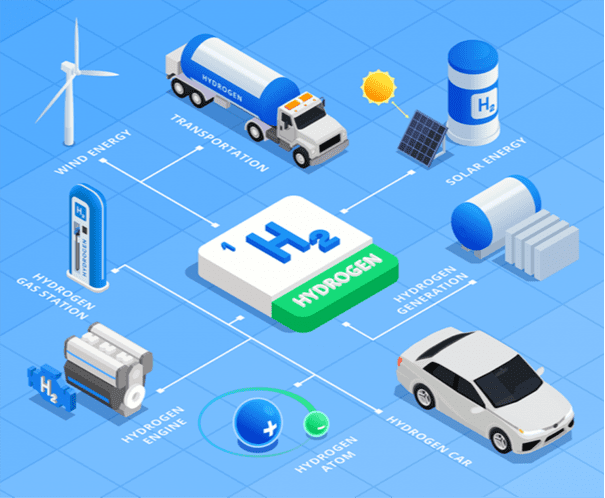What is fuel cell technology used for and why?

8 powerful industry applications
Although fuel cell technology is still in the early stages, some industries are further exploring its benefits:
Road transport: think long-haul trucks, but also personal vehicles and even buses. Several major cities around the world, like Beijing, Chicago and London, have experimented or are experimenting with buses powered by hydrogen fuel cells.
Warehouse logistics: fuel cells are increasingly powering industrial equipment, such as forklifts. This results in lower maintenance costs, improved run times and a smaller environmental footprint.
Trains: since the first hydrogen train for commercial use was put into service in 2018 in Germany, several other European countries have followed with orders, such as Italy, France and Austria. Extra benefit: these trains emit low noise levels.
Passenger ferries: the maritime sector emits about 2.5% of global carbon emissions. One of the short-term options to tackle this figure in a cost-competitive way is using fuel cells for passenger ferries.
Aviation: for short-haul flights in small airplanes (up to 20 passengers), hydrogen and fuel cells offer a viable option and are already trialed today. ZeroAvia, for example, is developing an aircraft for the world’s first commercial flight using the technology.
Backup power: more and more leading companies are looking at fuel cells for uninterruptable backup power. To illustrate, cloud giant Microsoft is already testing hydrogen backup generators for its data centers.
Portable power: specific applications include laptops, mobile phones, battery chargers and unmanned aerial vehicles. Light-weight PEM fuel cells prolong the amount of time these devices can be used.
Heat and power for buildings: the potential is enormous, since heat and power for buildings represents over a third of global energy demand and a quarter of global carbon emissions. PEM fuel cells can facilitate the sector’s energy transition.
“The technology readiness is highest for vehicles. That’s why we pull out all the stops to provide high-quality fuel cell catalysts that power clean mobility.”
Sascha Toelle, Global Manager Applied Technology & Sales at Umicore
Why do industries turn to PEM fuel cell technology?
In general, the following criteria drive industries towards the innovative technology:
Stricter legislation: whether at local, national or supranational level, public organizations are increasingly pushing for a more sustainable future. With stricter rules and regulations on reducing CO2 emissions, the goal is often to become carbon neutral. These ambitions inspire companies around the world to develop and adopt green(er) alternatives and energy sources, such as fuel cell electric vehicles and green hydrogen.
Lower costs: Fuel cell technology is surprisingly competitive as a low-carbon option for many industries. That is one of the main conclusions in the Hydrogen Council’s report Path to Hydrogen Competitiveness. At this point, that’s already the case for trucks, trains, long-range passenger vehicles and long-distance buses. For many other applications, it can become a viable alternative before 2030 under the right conditions and with a scale-up of hydrogen production and distribution.
Better performance: Fuel cells operate at relatively low temperatures (around 60-80°C), but have also proven themselves in freezing environments. This allows applications to start up quickly – with less warm-up time – and results in less wear and better durability. Other parameters like its compact size, limited weight and high power density make it even more suitable for certain applications.
Challenges for the future
At Umicore, we strongly believe fuel cells are part of the clean mobility future. However, for the technology to live up to its full potential, there are still some hurdles to be cleared:
 |
Policy alignment: governments should level the playing field by setting national targets, removing legal barriers, investing in infrastructure, offering incentives and facilitating standardization. Public acceptance: new technologies are rarely received with open arms by the public. Governments and industries must therefore collaborate to improve the reputation and understanding of fuel cell technology. Production and distribution of hydrogen: to increase the cost competitiveness of fuel cells, we’ll need to invest in the scale-up of production and distribution of renewable green hydrogen from electrolysis. Technological advancements: fuel cell technology should be further developed to cope with varying operating conditions, such as high pressure and extreme temperatures. |